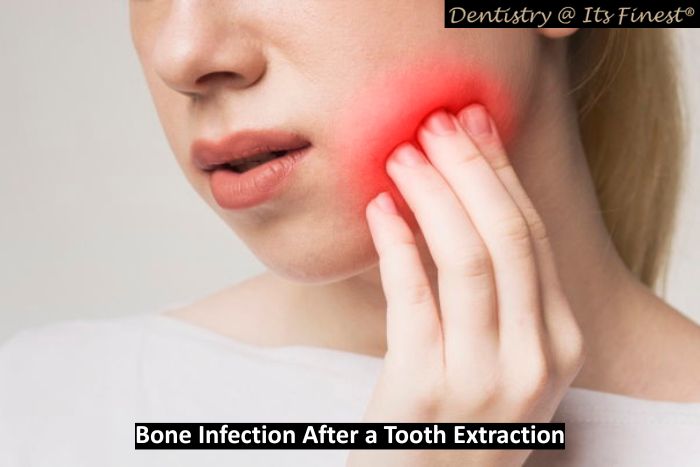A bone infection after tooth extraction occurs when bacteria enter the jawbone through the open socket left by the removed tooth, from poor healing, loss of the protective blood clot, or spread of a pre‑existing oral infection. This type of infection can cause deep, throbbing pain that worsens over time, swelling in the jaw or face, redness, warmth, pus drainage, bad breath, and sometimes fever or difficulty opening the mouth.
A tooth extraction is a dental procedure in which a tooth is carefully removed from its socket in the jawbone and gums. It is performed for reasons such as severe decay, advanced gum disease, overcrowding, impacted teeth, or damage from trauma, and is intended to relieve pain, prevent further oral health problems, and improve overall dental function.
What Happens if Infection After Tooth Extraction Spreads to the Bone?
If an infection after a tooth extraction spreads to the bone, it can result in a serious condition called osteomyelitis, which is a bacterial infection of the bone tissue. This occurs when bacteria from the extraction site enter the jawbone through the socket or the bloodstream, causing inflammation, swelling, and damage to the bone.
Early symptoms may include persistent or worsening pain, swelling that extends to the face or neck, fever, redness, and sometimes pus discharge from the extraction site. If left untreated, osteomyelitis can progress quickly, destroying surrounding bone, affecting nearby tissues, and in severe cases spreading to other parts of the body.
What Does a Bone Infection After Tooth Extraction Feel Like?
A bone infection after tooth extraction often feels more severe and persistent than normal healing discomfort. The pain is usually deep, throbbing, and may worsen instead of improving, sometimes spreading to the jaw, ear, or neck.
Other signs can include swelling that extends beyond the extraction site, warmth or redness in the area, and tenderness when touching the jaw. You might also notice a bad taste in the mouth, persistent bad breath, or pus drainage from the socket, and in more advanced cases, fever, chills, or difficulty opening the mouth.
What Causes Bone Infection After Tooth Extraction?
A bone infection after tooth extraction can develop when bacteria from the mouth enter the jawbone through the open socket left by the removed tooth. This can happen if the extraction site is not kept clean, if a pre‑existing infection in the tooth or gums spreads deeper, or if the blood clot that normally protects the socket is lost too soon, exposing bone and tissue to bacteria.
Infection can also reach the bone through the bloodstream if bacteria from another infected area travel and settle in the healing jawbone. Factors such as a weakened immune system, smoking, or trauma during extraction can increase the risk by slowing healing and making it easier for bacteria to invade. Once inside the bone, bacteria trigger inflammation and tissue damage, which can progress quickly without prompt treatment.
What are the Signs of Bone Infection After Tooth Extraction?
Signs of a bone infection after tooth extraction can develop within days to weeks and often become progressively worse rather than improving. The following are common symptoms of bone infection after tooth extraction.
- Experience persistent or worsening pain at the extraction site that does not improve with time or medication
- Notice swelling in the gums, jaw, face, or neck that feels warm or tender to the touch
- See redness around the extraction area or along the gumline
- Observe pus or fluid drainage from the socket, sometimes with a foul taste or odor
- Develop fever or chills as the body responds to infection
- Have difficulty opening the mouth or chewing due to pain and swelling
- Feel swollen lymph nodes in the neck or under the jaw
- Detect prolonged bad breath or an unpleasant taste that persists after cleaning
Recognizing these signs of bone infection after tooth extraction early is critical to preventing the condition from worsening or spreading. Seek urgent dental care if any of these symptoms appear, as untreated bone infections can spread and lead to serious complications.
Is It Common to Get Bone Infection After Tooth Extraction?
No, it is not common to get a bone infection after tooth extraction. Most extractions heal without complications when proper aftercare is followed, but in rare cases bacteria can enter the extraction site and spread to the jawbone, especially if there was a pre‑existing infection, the immune system is weakened, or post‑extraction care is neglected.
How to Treat Bone Infection After Tooth Extraction?
Bone infection after tooth extraction treatment focuses on stopping the spread of bacteria, relieving symptoms, and restoring healthy bone and tissue. The exact approach depends on how advanced the infection is, but it often includes the following.
- Prescribing antibiotics to target and eliminate the bacteria causing the infection
- Draining any abscess or infected fluid to reduce pressure and swelling
- Surgically cleaning the area to remove infected bone or tissue if the infection is severe
- Flushing the socket with an antimicrobial solution to clear debris and bacteria
- Providing pain management to keep the patient comfortable during recovery
- Recommending follow‑up visits to monitor healing and ensure the infection has fully resolved
How Serious is a Jaw Bone Infection After a Tooth Extraction?
A jaw bone infection after a tooth extraction is a serious condition that can damage bone tissue, spread to surrounding areas, and lead to severe health complications if untreated. Prompt diagnosis and treatment are essential to prevent long‑term damage or life‑threatening spread.
How Long After Tooth Extraction Can Osteomyelitis Occur?
Osteomyelitis can develop within days to weeks after a tooth extraction if bacteria enter the bone, but in some cases it may appear months later. The timing depends on factors like overall health, presence of pre‑existing infection, and how well the site heals.

